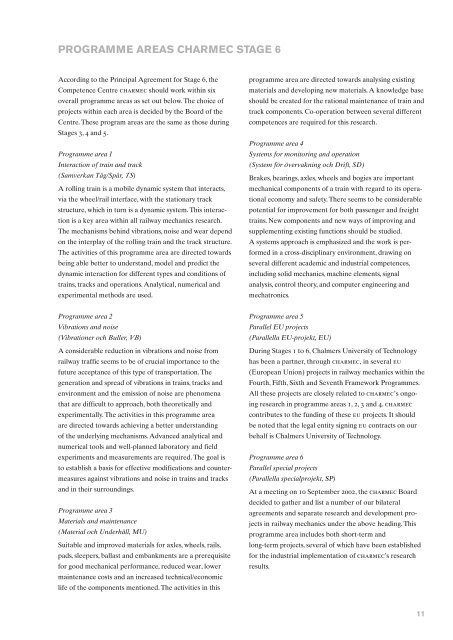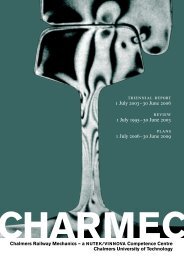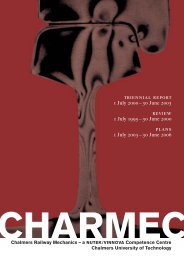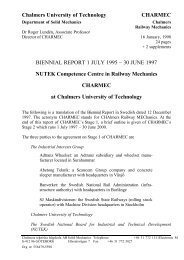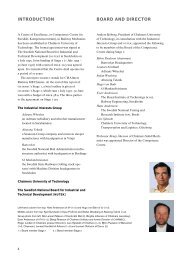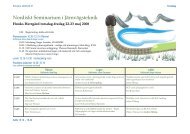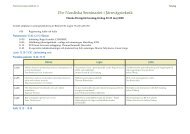stage 6 triennial report 1 July 2009–30 June 2012 ... - CHARMEC
stage 6 triennial report 1 July 2009–30 June 2012 ... - CHARMEC
stage 6 triennial report 1 July 2009–30 June 2012 ... - CHARMEC
Create successful ePaper yourself
Turn your PDF publications into a flip-book with our unique Google optimized e-Paper software.
PROGRAMME AREAS ChARMEC STAGE 6<br />
According to the Principal Agreement for Stage 6, the<br />
Competence Centre charmec should work within six<br />
overall programme areas as set out below. The choice of<br />
projects within each area is decided by the Board of the<br />
Centre. These program areas are the same as those during<br />
Stages 3, 4 and 5.<br />
Programme area 1<br />
Interaction of train and track<br />
(Samverkan Tåg/Spår, TS)<br />
A rolling train is a mobile dynamic system that interacts,<br />
via the wheel/rail interface, with the stationary track<br />
structure, which in turn is a dynamic system. This interaction<br />
is a key area within all railway mechanics research.<br />
The mechanisms behind vibrations, noise and wear depend<br />
on the interplay of the rolling train and the track structure.<br />
The activities of this programme area are directed towards<br />
being able better to understand, model and predict the<br />
dynamic interaction for different types and conditions of<br />
trains, tracks and operations. Analytical, numerical and<br />
experimental methods are used.<br />
Programme area 2<br />
Vibrations and noise<br />
(Vibrationer och Buller, VB)<br />
A considerable reduction in vibrations and noise from<br />
railway traffic seems to be of crucial importance to the<br />
future acceptance of this type of transportation. The<br />
generation and spread of vibrations in trains, tracks and<br />
environment and the emission of noise are phenomena<br />
that are difficult to approach, both theoretically and<br />
experimentally. The activities in this programme area<br />
are directed towards achieving a better understanding<br />
of the underlying mechanisms. Advanced analytical and<br />
numerical tools and well-planned laboratory and field<br />
experiments and measurements are required. The goal is<br />
to establish a basis for effective modifications and countermeasures<br />
against vibrations and noise in trains and tracks<br />
and in their surroundings.<br />
Programme area 3<br />
Materials and maintenance<br />
(Material och Underhåll, MU)<br />
Suitable and improved materials for axles, wheels, rails,<br />
pads, sleepers, ballast and embankments are a prerequisite<br />
for good mechanical performance, reduced wear, lower<br />
maintenance costs and an increased technical/economic<br />
life of the components mentioned. The activities in this<br />
programme area are directed towards analysing existing<br />
materials and developing new materials. A knowledge base<br />
should be created for the rational maintenance of train and<br />
track components. Co-operation between several different<br />
competences are required for this research.<br />
Programme area 4<br />
Systems for monitoring and operation<br />
(System för övervakning och Drift, SD)<br />
Brakes, bearings, axles, wheels and bogies are important<br />
mechanical components of a train with regard to its operational<br />
economy and safety. There seems to be considerable<br />
potential for improvement for both passenger and freight<br />
trains. New components and new ways of improving and<br />
supplementing existing functions should be studied.<br />
A systems approach is emphasized and the work is performed<br />
in a cross-disciplinary environment, drawing on<br />
several different academic and industrial competences,<br />
including solid mechanics, machine elements, signal<br />
analysis, control theory, and computer engineering and<br />
mechatronics.<br />
Programme area 5<br />
Parallel EU projects<br />
(Parallella EU-projekt, EU)<br />
During Stages 1 to 6, Chalmers University of Technology<br />
has been a partner, through charmec, in several eu<br />
(European Union) projects in railway mechanics within the<br />
Fourth, Fifth, Sixth and Seventh Framework Programmes.<br />
All these projects are closely related to charmec’s ongoing<br />
research in programme areas 1, 2, 3 and 4. charmec<br />
contributes to the funding of these eu projects. It should<br />
be noted that the legal entity signing eu contracts on our<br />
behalf is Chalmers University of Technology.<br />
Programme area 6<br />
Parallel special projects<br />
(Parallella specialprojekt, SP)<br />
At a meeting on 10 September 2002, the charmec Board<br />
decided to gather and list a number of our bilateral<br />
agreements and separate research and development projects<br />
in railway mechanics under the above heading. This<br />
programme area includes both short-term and<br />
long-term projects, several of which have been established<br />
for the industrial implementation of charmec’s research<br />
results.<br />
11


